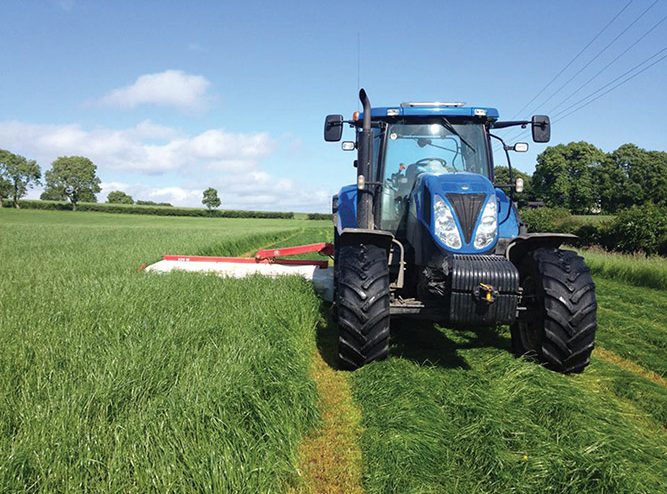
D&S McMurran Dairy Farm near Banbridge in Co. Down is home to one of the highest producing dairy herds in Ireland. Darren McMurran explains more.
Two years ago, Darren and his brother Stuart had the top placed production herd in Northern Ireland in the National Milk Record’s annual production report with an annual yield of 12,044kg in their 300-cow herd. In the last six months, they have increased the herd size to 400 and may go to 450 in the near future.
“We don’t want to bite off more than we can chew. The dairy sector has gone through a tough couple of years. Hopefully, milk prices will improve soon, but for now it’s all about trying to keep costs down and being as efficient as possible,” Darren says.
When Darren and Stuart took over the enterprise following the death of their father Robert in 1996, they were milking just 30 cows. It wasn’t until they purchased their current farm in 2005 that they were able to increase numbers and ramp up production.
“We originally had a farm three miles up the road in Dromore, but sold most of that and bought this one in Castlevennon,” Darren explains.
“We had built up the herd to 70, but that was our limit as far as the old farm was concerned. We bought 110 cows as part of the farm purchase and had a swing over, 24-a-side Dairymaster milking parlour installed by Cookstown Dairy Services. Combined with the 15 acres we held onto in Dromore, we have 170 acres in total. We kept the farm buildings in Dromore which we use to rear replacement heifers.”
Last year, the brothers introduced sand bedding to the farm for the first time. Sand bedding is considered the gold standard for bedding dairy cows. Its benefits include few cases of mastitis and comfortable, happy and healthy cows.
“We built a new shed with sand bedding for 155 cows after seeing how it worked in the US. Sand bedding offers great comfort to the cows and this has been reflected in a three-litre increase per cow a day. The only downsize to sand bedding is handling the slurry. But we have a system in place that allows us to overcome this.”
The McMurran herd is housed all year around with three times a day milking. Not including Darren and Stuart, the farm employs two full-time staff. The brothers receive tremendous support from their mother May, while Darren’s wife Laura also offers a helping hand.
The herd is arranged in four groups – dry cows, young heifers, high yielders and freshly calved cows. There is a strong emphasis on dry cow management in order to prepare them for the next lactation. Calving takes place throughout the year. Fed on pasteurised milk, the heifer calves are in individual hutches until they are eight weeks old when they are grouped and are weaned over two weeks on an automatic feeder. While the bull calves are sold at four-six weeks old, the heifers are weighed and measured for bulling at 13 months and calving at 24 months. There are currently 300 replacement heifers on the farm.
The enterprise, which supplies its milk to Lakeland Dairies, has come a long way from 20 years ago ago when the annual yield was just 6,500 litres. Two years ago, the herd had an annual yield of 12,044kg with butterfat at 3.67 per cent and protein at 3.03 per cent. The heifer yield was 11,343kg at 3.47 per cent butterfat and 2.94 per cent protein. In addition, the McMurran’s had the second highest yielding cow and claimed first place in genetic management.
Asked how such impressive figures can be achieved, Darren replies: “Constantly evaluate what you are doing, keep up to date with new knowledge and developments, utilise fully the expertise and advice of everyone who has an input to the farm and, after that, a lot of hard work.
“For example, the National Milk Record’s herd recording service enables us to see exactly what is happening with each cow in the herd and the genetic management advice from Genus ABS has helped us to continually improve the breeding, production, health and longevity of the herd. They have also facilitated opportunities to access new research and ideas.”
Wholecrop maize and silage is fed in a TMR system with a top-up according to the yield in the milking parlour. The brothers cut silage five times a year using their own equipment. They run five tractors – two Fendts, two McCormicks and one New Holland – as well as a Claas 850 self-propelled harvester, three Lely mowers, two tethers and a silage rake. They’ve also recently invested in a new Agquip dribble bar umbilical system.
“We wouldn’t be in a position to cut our own silage without the help of neighbours and friends. We’re very lucky in that regard. We try to be as self-sufficient as possible and thereby keep costs down. You won’t make a living from this business by overspending,” the straight-talking Co. Down dairy farmer concludes.
D&S McMurran Dairy Farm
Castlevennon,
Castlevennon Road,
Banbridge
BT32 3SD
Telephone: 078 55484330
Taken from Irish Tractor & Agri magazine Vol 4 No 9, November/December 2016